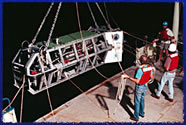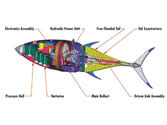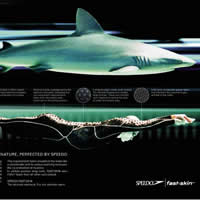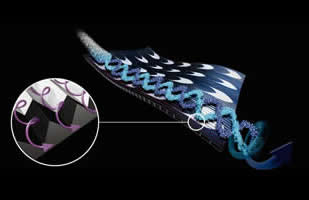|
>> Catalog of Tomorrow Rough Drafts: Deep Sea | SETI | Deep Space
|
|||||||
|
We already live on Waterworld: oceans cover over seventy percent of the Earth's surface. With scuba gear, divers routinely swim to depths of 300 feet. But everything below that is considered "deep sea," and deep sea comprises 60% of our oceans. Here, then, is both the opportunity and the risk: the ocean depths offer more daunting technical challenges than deep space. But, you think, the vacuum! temperature fluctuations of several hundred degrees! radiation! Space vehicles must tolerate sunside temperatures of 250 F in tandem with lows of 250 F, and shield their contents against both radiation and space debris. Yet deep ocean vehicles must tolerate a similar temperature variance -- 35 F in the coldest depths to 750 F near hydrothermal vents -- as well as protect against one of the most corrosive substances on Earth: saltwater. Where astronauts need only suit up for a one atmosphere difference in pressure, divers endure a one atmosphere increase in pressure for every 33 feet (10 meters) they descend. Furthermore, as Marcia
McNutt, CEO of MBARI (Monterey Bay
Aquarium Research Institute), reminds us, "solar panels are
capable of powering most interplanetary voyages, but sunlight does
not penetrate beyond the uppermost regions of the ocean. Space is
virtually transparent to the transmission of electromagnetic energy,
while the oceans are opaque to [it]." Consequently, many deepsea
exploration devices are tethered to their launch platforms. Imagine
this limitation in space. (graphic of space shuttle w/ extension
cord?) |
|||||||
   
|
|||||||
|
But let us go and make our visit: how do we get there? Basically, we have three choices. We can visit the ocean depths virtually, piggy-backing on the senses of aquatic robots and remotely operated exploration tools. Or we can build vessels that withstand the temperatures, the saltwater, and the pressures, and visit the sea depths in the nautilus shell of our own inventiveness. On the horizon, emerging technologies might one day enable us to build "sea suits," and explore in conditions more nearly skin to sea (see "Biomimetics," linked at tubeworms and squid, above). We extend our virtual reach beneath the waves with three kinds of tools. Using cables, we lower sensor arrays from ships, as the oceanographer Robert Ballard did to explore the Titanic with the sensor sled Argo. We build undersea robots, like Japan's Aqua Explorer 2000, or Woods Hole's ABE (Autonomous Benthic Explorer). Or we deploy sensor stations on the ocean floor, like the GEOSTAR station of the Mediterranean "Biodeep" project. Economics and durability both support continued use of towed equipment arrays, but microminiaturization, chip design, new materials research, and biomimetic robotics (see sidebar) point to autonomous undersea vehicles (AUVs) and robots as key marine tools of tomorrow. In essence, we are designing the next benthic life-form: it will hunt anomalies, taste its surroundings, excrete data, and return to us periodically to ingest energy for continued existence. It may not even need batteries, using heat engines to generate energy from ocean temperature differentials, like the new Slocum Glider. For the sake of efficient propulsion, this silicon seabeast will mimic its organic neighbors in design. Draper Laboratory's newest autonomous ocean robot is modeled after a yellowfin tuna. Simpler additions to our technological aquarium will drift along passively collecting data: tiny, free-floating robots will include chemical sensors on their microchips and buckytubes to filter particulates for analysis. These zooplankton mimics will trade and pool data among themselves and store observations until sucked up by a larger robofish for collection. All this robotic sea life will function within an ecosystem of instrumentation rather than kelp, an ecosystem emerging from initiatives like the Neptune project. An underwater observatory stretching from Vancouver Island to northern California, the Neptune project will feature 2,000-miles of fiber optic cable, a host of free-roaming AUVs, and high-definition television cameras. As of 2006, your video wallpaper could display live feed from the deep ocean (of course, by 2015 the opposite wall may feature live feed from Mars). |
|||||||
|
In 1953 Auguste Piccard and his son Jacques dove nearly two miles into the ocean depths in the bathyscaph Trieste. Alvin, which currently holds the highest use record, can only dive to about 3,000 meters. The newest 3-passenger exploration submersible, Japan's Shinkai 6500, is sleeker, more maneuverable, safer, and can reach depths of 6,500 meters. But even these submersibles use twentieth century technology. Graham Hawkes, a private entrepreneur and inventor, believes that "closer and endlessly richer in life, resources and mysteriesŠ it is earth's oceans not space that will fuel man's future into the next century." His response to this imperative is the world's first underwater "aircraft," Deep Flight. A single-person submersible, the pilot plunges into the deep in a prone position. Inverted wings on the craft create "negative" lift, pulling the sub into the ocean depths without need for ballast. This enables a fast descent, optimizing "bottom time" for exploration purposes. Deep Flight II will be proven to over 12,000 meters with an "Ocean Everest" expedition to the Marianas Trench. Deep Flight's smaller cousins will basically be atmospheric dive suits with attitude. Atmospheric dive suits (ADS) are by definition jointed, human-shaped, single-person submersibles which can descend to almost 760 meters while maintaining internal pressure close to one atmosphere. This eliminates the need for compression or decompression schedules, but requires a suit so heavy the wearer moves it using built-in propulsion. The next generation of ADS will easily reach depths of 1,000 meters, include directional thrusters for increased maneuverability, and carry enhanced sensor, data, and communication arrays onboard. But the Exosuit, designed by Dr. Phil Nuytten, represents the most promising future for ADS a lightweight, non-tethered dive suit so flexible that divers will be able to swim wearing it. |
|||||||
   |
|||||||
|
Scuba gear and wetsuits come as close to swimming like fish as humans can get. New materials developments may allow us literally to swim like fish or like sharks and dolphins (see "Biomimetics," above). But access to the ocean depths requires more than streamlining the hydrodynamically clumsy human form. It means addressing the dangers inherent in being an air-breathing mammal in a high-pressure environment. One potential answer would be a fluid breathing apparatus, like that spotlighted in the movie "Abyss." Replacing the air in our lungs with a highly oxygenated fluid would sidestep the decompression difficulties arising from breathing gases under pressure. Such a liquid perflubron (perfluorooctyl bromide) is currently undergoing clinical trials for therapeutic use with patients suffering respiratory failure from infection, burns, toxic substances, or premature birth. Significant technical problems circulating the liquid easily through the lungs, eliminating the carbon dioxide that is exhaled, draining the lungs in the transition back to breathing air mean this technology will take a decade or more to develop. But its development will allow humans much greater freedom of the depths. In the very long term,
beyond the scope of this book, we may know enough not only about
ourselves, but also about our marine neighbors -- dolphins, orcas,
blue whales -- to understand how they survive plummeting to great
depths and rising again to the sun and the sky, in one breath. We
may then apply that understanding to redesigning our own physiognomy.
And so, in some far future, we may need to paraphrase Shakespeare
to visualize our childrens' lives: |
|||||||
|
|||||||
> Essays > Change > Octopus | Tomorrow | Arts | Governance | America's Futures | Borders
>> Catalog of Tomorrow Rough Drafts: Deep Sea | SETI | Deep Space
| 15
February 2003. Email
IF. Copyright © 2003, Wendy L. Schultz All rights reserved. |
people have explored our infinite futures. (in addition to the 17,500+ visitors from 10/1/2001-12/15/2002). |




















